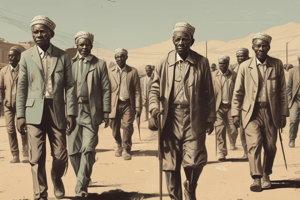Podcast
Questions and Answers
What percentage of the country's land was initially reserved for black South Africans?
What percentage of the country's land was initially reserved for black South Africans?
- 5%
- 15%
- 8% (correct)
- 10%
What was one of the consequences of the Natives Land Act for traditional family structures?
What was one of the consequences of the Natives Land Act for traditional family structures?
- Disruption of traditional family structures (correct)
- Increased women's participation in agriculture
- Strengthening of family bonds
- Improved living conditions
What was the outcome of the migrant labor system on black South Africans?
What was the outcome of the migrant labor system on black South Africans?
- Increased access to education
- Significant social strain (correct)
- Better living conditions
- Improved economic opportunities
What was the primary purpose of the Natives Land Act from the perspective of the mining industry?
What was the primary purpose of the Natives Land Act from the perspective of the mining industry?
Who documented the devastating effects of the Natives Land Act?
Who documented the devastating effects of the Natives Land Act?
What was the outcome of Sol Plaatje's efforts to resist the Land Act?
What was the outcome of Sol Plaatje's efforts to resist the Land Act?
What was the ultimate consequence of the Natives Land Act?
What was the ultimate consequence of the Natives Land Act?
What percentage of the country's land was eventually reserved for black South Africans?
What percentage of the country's land was eventually reserved for black South Africans?
What was the primary outcome of the 1913 Land Act in terms of racial relations in South Africa?
What was the primary outcome of the 1913 Land Act in terms of racial relations in South Africa?
What was a consequence of the economic disenfranchisement brought about by the 1913 Land Act?
What was a consequence of the economic disenfranchisement brought about by the 1913 Land Act?
What was a social consequence of the 1913 Land Act?
What was a social consequence of the 1913 Land Act?
What is the legacy of the 1913 Land Act a reminder of?
What is the legacy of the 1913 Land Act a reminder of?
When did the significant impact of the 1913 Land Act on South African society end?
When did the significant impact of the 1913 Land Act on South African society end?
What was a primary effect of the 1913 Land Act on the black South African population?
What was a primary effect of the 1913 Land Act on the black South African population?
How did the 1913 Land Act affect the economic life of black South Africans?
How did the 1913 Land Act affect the economic life of black South Africans?
What was a social consequence of the 1913 Land Act?
What was a social consequence of the 1913 Land Act?
What does the legacy of the 1913 Land Act remind us of?
What does the legacy of the 1913 Land Act remind us of?
When did the significance of the 1913 Land Act's impact on South African society end?
When did the significance of the 1913 Land Act's impact on South African society end?
What was the primary reason for the development of the migrant labor system in South Africa?
What was the primary reason for the development of the migrant labor system in South Africa?
What was the primary outcome of the economic exploitation facilitated by the Natives Land Act?
What was the primary outcome of the economic exploitation facilitated by the Natives Land Act?
What was the significance of Sol Plaatje's book 'Native Life in South Africa'?
What was the significance of Sol Plaatje's book 'Native Life in South Africa'?
What was the ultimate consequence of the Natives Land Act in terms of racial segregation in South Africa?
What was the ultimate consequence of the Natives Land Act in terms of racial segregation in South Africa?
What was the primary consequence of the displacement of black South Africans from fertile land to overcrowded and less arable areas?
What was the primary consequence of the displacement of black South Africans from fertile land to overcrowded and less arable areas?
What was the role of the British government in response to Sol Plaatje's appeals against the Natives Land Act?
What was the role of the British government in response to Sol Plaatje's appeals against the Natives Land Act?
What was a consequence of the Natives Land Act on the social structures of black South Africans?
What was a consequence of the Natives Land Act on the social structures of black South Africans?
What was the primary motivation behind the passing of the Natives Land Act?
What was the primary motivation behind the passing of the Natives Land Act?
What was the outcome of the 1913 Land Act on the economic life of black South Africans?
What was the outcome of the 1913 Land Act on the economic life of black South Africans?
What was a consequence of the social fragmentation caused by the 1913 Land Act?
What was a consequence of the social fragmentation caused by the 1913 Land Act?
What is the legacy of the 1913 Land Act a reminder of?
What is the legacy of the 1913 Land Act a reminder of?
What was an effect of the 1913 Land Act on racial relations in South Africa?
What was an effect of the 1913 Land Act on racial relations in South Africa?
What is the significance of the 1913 Land Act in modern South Africa?
What is the significance of the 1913 Land Act in modern South Africa?
What was the primary consequence of the Natives Land Act for black South Africans' livelihoods?
What was the primary consequence of the Natives Land Act for black South Africans' livelihoods?
What was the primary effect of the Natives Land Act on the economic life of black South Africans?
What was the primary effect of the Natives Land Act on the economic life of black South Africans?
What was the significance of the Natives Land Act in terms of racial segregation in South Africa?
What was the significance of the Natives Land Act in terms of racial segregation in South Africa?
What was the role of Sol Plaatje in the resistance against the Natives Land Act?
What was the role of Sol Plaatje in the resistance against the Natives Land Act?
What was the primary consequence of the displacement of black South Africans from fertile land to overcrowded and less arable areas?
What was the primary consequence of the displacement of black South Africans from fertile land to overcrowded and less arable areas?
What was the primary motivation behind the Natives Land Act?
What was the primary motivation behind the Natives Land Act?
What was the outcome of the migrant labor system on black South Africans' social structures?
What was the outcome of the migrant labor system on black South Africans' social structures?
What was the ultimate consequence of the Natives Land Act in terms of South African society?
What was the ultimate consequence of the Natives Land Act in terms of South African society?
What was the primary consequence of institutionalized racism in South Africa during the apartheid era?
What was the primary consequence of institutionalized racism in South Africa during the apartheid era?
What was the primary effect of the 1913 Land Act on the economic life of black South Africans?
What was the primary effect of the 1913 Land Act on the economic life of black South Africans?
What was the social consequence of the 1913 Land Act on black South African communities?
What was the social consequence of the 1913 Land Act on black South African communities?
What is the legacy of the 1913 Land Act a reminder of?
What is the legacy of the 1913 Land Act a reminder of?
When did the significant impact of the 1913 Land Act on South African society end?
When did the significant impact of the 1913 Land Act on South African society end?
What was the primary mechanism by which the Natives Land Act of 1913 facilitated the economic exploitation of black South Africans?
What was the primary mechanism by which the Natives Land Act of 1913 facilitated the economic exploitation of black South Africans?
What was the primary consequence of the migrant labor system on traditional family structures of black South Africans?
What was the primary consequence of the migrant labor system on traditional family structures of black South Africans?
What was the primary role of Sol Plaatje in the context of the Natives Land Act?
What was the primary role of Sol Plaatje in the context of the Natives Land Act?
What was the primary outcome of the Natives Land Act in terms of racial segregation in South Africa?
What was the primary outcome of the Natives Land Act in terms of racial segregation in South Africa?
What was the primary reason behind the restriction of black South Africans to reserves?
What was the primary reason behind the restriction of black South Africans to reserves?
What was the primary consequence of the displacement of black South Africans from fertile land to overcrowded and less arable areas?
What was the primary consequence of the displacement of black South Africans from fertile land to overcrowded and less arable areas?
What was the primary motivation behind the British government's response to Sol Plaatje's appeals against the Natives Land Act?
What was the primary motivation behind the British government's response to Sol Plaatje's appeals against the Natives Land Act?
What was the primary legacy of the Natives Land Act of 1913?
What was the primary legacy of the Natives Land Act of 1913?




